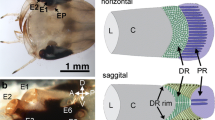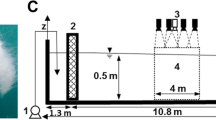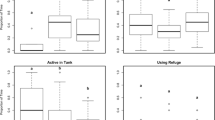Abstract
Reversibly blindfolded crayfish (Procambarus clarkii) react to small swimming fish (Astyanax fasciatus mexicanus) approaching or passing nearby with antennal and cheliped movements and body turns (Fig. 3). We studied the accuracy and dynamics of crayfish orientation responses to the previously analyzed hydrodynamic disturbances caused by the fish, mostly produced by tail flicks.
Antennal and cheliped movements started slightly before the onset of turning responses (Fig. 4). Antennal sweeps were performed most rapidly. 50% of the appendage sweeps resulted in contacts with the fish (Fig. 5).
Most turns were directed toward the stimulus (Fig. 6). Response amplitudes increased with increasing stimulus angle. Turns were accurate for small stimulus angles, but smaller than expected for larger ones. Sweeps of ipsilateral antennae and chelipeds were generally directed backwards, while those of contralateral appendages were smaller and directed forwards. The amplitudes of appendage sweeps first increased with increasing stimulus angle and then decreased again for more caudal stimulus directions. Lateral stimuli (60°–120°) from opposite sides were usually significantly distinguished. The amplitudes of the different elements of orientation behaviour were highly correlated with each other, indicating that they were directed by the same sensory input.
Similar content being viewed by others

References
Ache BW (1982) Chemoreception and thermoreception. In: Atwood HL, Sandeman DC (eds) The biology of Crustacea, Vol 3, Neurobiology: structure and function. Academic Press, New York, pp 369–398
Atema J (1988) Distribution of chemical stimuli. An: Atema J, Fay RR, Popper AN, Tavolga WN (eds) Sensory biology of aquatic animals. Springer, Berlin Heidelberg New York, pp 29–56
Batschelet E (1981) Circular statistics in biology. Academic Press, London New York Toronto Sydney San Francisco
Bender M, Gnatzy W, Tautz J (1984) The antennal feathered hairs in the crayfish: a non-innervated stimulus transmitting system. J Comp Physiol A 154: 45–47
Bleckmann H (1988) Prey identification and prey localization in surface-feeding fish and fishing spiders. In: Atema J, Fay RR, Popper AN, Tavolga WN (eds) Sensory biology of aquatic animals. Springer, Berlin Heidelberg New York, pp 619–641
Bleckmann H (1994) Reception of hydrodynamic stimuli in aquatic and semiaquatic animals. Fortschr Zool, Bd 41. G. Fischer, Stuttgart Jena New York
Bleckmann H, Breithaupt T, Blickhan R, Tautz J (1991) The time course and frequency content of hydrodynamic events caused by moving fish, frogs, and crustaceans. J Comp Physiol A 168: 749–757
Blickhan R, Krick C, Zehren D, Nachtigall W, Breithaupt T (1992) Generation of a vortex chain in the wake of a subundulatory swimmer. Naturwissenschaften 79: 220–221
Bovbjerg RV (1953) Dominance order in the crayfish Orconectes virilis (Hagen). Physiol Zool 26: 173–178
Breithaupt T (1991) Frequenzgehalt und Struktur hydrodynamischer Signale und deren Wahrnehmung durch Flußkrebse. Dissertation, Universität Konstanz
Breithaupt T, Ayers J (1995) Visualization and quantitative analysis of biological flow fields using suspended particles. Mar Freshw Behav Physiol (in press)
Breithaupt T, Tautz J (1988) Vibration sensitivity of the crayfish statocyst. Naturwissenschaften 75: 310–312
Breithaupt T, Tautz J (1990) The sensitivity of crayfish mechanoreceptors to hydrodynamic and acoustic stimuli. In: Wiese K, Krenz W-D, Tautz J, Reichert H, Mulloney B (eds) Frontiers in crustacean neurobiology. Advances in life sciences. Birkhäuser, Basel, pp 114–120
Budelmann BU (1989) Hydrodynamic receptor systems in invertebrates. In: Coombs S, Görner P, Münz H (eds) The mechanosensory lateral line: Neurobiology and evolution. Springer, Berlin Heidelberg New York, pp. 607–631
Budelmann BU (1992) Hearing in Crustacea. In: Webster DB, Fay RR, Popper AN (eds) The evolutionary biology of hearing. Springer, Berlin Heidelberg New York, pp 131–139
Coombs S, Janssen J (1989) Peripheral processing by the lateral line system of the mottled sculpin (Cottus bairdi). In: Coombs S, Görner P, Münz H (eds) The mechanosensory lateral line: Neurobiology and evolution. Springer, Berlin Heidelberg New York, pp 229–319
Copp NH, Watson D (1988) Visual control of turning responses to tactile stimuli in the crayfish Procambarus clarkii. J Comp Physiol A 163: 175–186
Ebina Y, Wiese K (1984) A comparison of neuronal and behavioural thresholds in the displacement-sensitive pathway of the crayfish Procambarus. J Exp Biol 108: 45–55
Enger PS, Kalmijn AJ, Sand O (1989) Behavioral investigations on the functions of the lateral line and inner ear in predation. In: Coombs S, Görner P, Münz H (eds) The mechanosensory lateral line: Neurobiology and Evolution. Springer Berlin Heidelberg, New York, pp 575–587
Fernández de Miguel F, Aréchiga H (1994) Circadian locomotor activity and its entrainment by food in the crayfish Procambarus clarkii. J Exp Biol 190: 9–21
Hawkins AD (1985) The mechanical senses of aquatic organisms. In: Laverack MS (ed) Physiological adaptations of marine animals. The Company of Biologists Ltd, Cambridge, pp 425–458
Hoekstra D, Janssen J (1986) Lateral line receptivity in the mottled sculpin (Cottus bairdi). Copeia 1986: 91–96
Hogger JB (1988) Ecology, population biology and behaviour. In: Holdich DM, Lowery RS (eds) Freshwater crayfish. Biology, management and exploitation. Croom Helm, London, and Timber Press, Portland, pp 114–144
Kalmijn AJ (1988) Hydrodynamic and acoustic field detection. In: Atema J, Fay RR, Popper AN, Tavolga WN (eds) Sensory biology of aquatic animals. Springer, New York, pp 83–130
Kelly TM, Chapple WD (1990) Kinematic analysis of the defense response in crayfish. J Neurophysiol 64: 64–76
Laverack MS (1988) The diversity of chemoreceptors. In: Atema J, Fay RR, Popper AN, Tavolga WN (eds) Sensory biology of aquatic animals. Springer, Berlin Heidelberg New York, pp 287–312
Marshall NB (1971) Explorations in the life of fishes. Harvard University Press, Cambridge
Masters WM, Aicher B, Tautz J, Markl H (1982) A new type of water vibration receptor in the crayfish antenna. II. Model of receptor function. J Comp Physiol 149: 409–422
McCutchen CW (1977) Froude propulsive efficiency of a small fish, measured by wake visualisation. In: Pedley TJ (ed) Scale effects in locomotion. Academic Press, London, pp 339–363
Mellon DeF (1963) Electrical responses from dually innervated tactile receptors on the thorax of the crayfish. J Exp Biol 40: 137–148
Montgomery JC (1989) Lateral line detection of planktonic prey. In: Coombs S, Görner P, Münz H (eds) The mechanosensory lateral line: Neurobiology and evolution. Springer, New York, pp. 561–574
Moore PA, Scholz N, Atema J (1991) Chemical orientation of lobsters, Homarus americanus, in turbulent odor plumes. J Chem Ecol 17: 1293–1307
Ozeki M, Takahata M, Hisada M (1978) Afferent response patterns of the crayfish statocyst with ferrite grain statolith to magnetic field stimulation. J Comp Physiol 123: 1–10
Plummer MR, Tautz J, Wine JJ (1986) Frequency coding of waterborne vibrations by abdominal mechanosensory interneurons in the crayfish, Procambarus clarkii. J Comp Physiol A 158: 751–764
Rahel FJ, Stein RA (1988) Complex predator-prey interaction and predator intimidation among crayfish, piscivorous fish, and small benthic fish. Oecologia (Berlin) 75: 94–98
Riemay H (1980) Zur Kenntnis mechanorezeptiver Cuticularsensillen auf den Pereiopoden von Orconectes limosus Raf. Zool Jb Physiol 84: 226–230
Rohlf FJ, Sokal RR (1981) Statistical tables. WH Freeman and Company, New York
Sandeman DC (1985) Crayfish antennae as tactile organs: their mobility and the responses of their proprioreceptors to displacement. J Comp Physiol A 157: 363–373
Sandeman DC (1989) Physical properties, sensory receptors and tactile reflexes of the antenna of the Australian freshwater crayfish Cherax destructor. J Exp Biol 141: 197–217
Sandeman DC, Varjú D (1988) A behavioural study of tactile localization in the crayfish Cherax destructor. J Comp Physiol A 163: 525–536
Schmitz B (1992a) Postembryonic development of the crayfish Procambarus clarkii and its tailfan mechanosensory system. In Singh RN (ed) Nervous system: Principles of design and function. Wiley Eastern, New Delhi, pp 69–90
Schmitz B (1992b) Directionality of antennal sweeps elicited by water jet stimulation of the tailfan in the crayfish Procambarus clarkii. J Comp Physiol A 171: 617–627
Schmitz B, Bosch W, Drömer R (1993) The telson mechanosensory system in the crayfish Procambarus clarkii: Development and connectivity in the central nervous system. In: Wiese K, Gribakin FG, Popov AV, Renninger G (eds) Sensory systerms of arthropods. Birkhäuser, Basel Boston Berlin, pp 431–438
Sokal RR, Rohlf FJ (1981) Biometry, WH Freeman and Company, New York
Takahata M, Komatsu H, Hisada M (1984) Positional orientation determined by the behavioural context in Procambarus clarkii Girard (Decapoda: Macrura). Behaviour 88: 240–265
Tautz J (1987a) Water vibralion elicits active antennal movements in the crayfish, Orconectes limosus. Anim Behav 35: 748–754
Tautz J (1987b) Interneurons in the tritocerebrum of the crayfish. Brain Res 407: 230–239
Tautz J (1990) Can the directional sensitivity of single mechanosensory neurons in arthropods tell the animal anything about stimulus direction? In: Gribakin FG, Wiese K, Popov AV (eds) Sensory systems and communication in arthropods. Birkhäuser, Basel, pp 359–363
Tautz J, Plummer MR (1994) Comparison of directional selectivity in identified spiking and nonspiking mechanosensory neurons in the crayfish Orconectes limosus. Proc Natl Acad Sci USA 91: 5853–5857
Tautz J, Sandeman DC (1980) The detection of waterborne vibration by sensory hairs on the chelae of the crayfish. J Exp Biol 88: 351–356
Tautz J, Masters WM, Aicher B, Markl H (1981) A new type of water vibration receptor on the crayfish antenna. I. Sensory physiology. J Comp Physiol A 144: 533–541
Voigt R, Atema J (1992) Tuningof chemoreceptor cells of the second antenna of the American lobster (Homarus americans) with a comparison of four of its other chemoreceptor organs. J Comp Physiol A 171: 673–681
Wiese K (1976) Mechanoreceptors for near-field water displacements in crayfish. J Neurophysiol 39: 816–833
Wiese K (1988) The representation of hydrodynamic parameters in the CNS of the crayfish Procambarus. In: Atema J, Fay RR, Popper AN, Tavolga WN (eds) Sensory biology of aquatic animals. Springer, Berlin Heidelberg New York, pp 665–683
Zeil J, Sandeman R, Sandeman DC (1985) Tactile localisation: the function of active antennal movements in the crayfish Cherax destructor. J Comp Physiol A 157: 607–617
Author information
Authors and Affiliations
Rights and permissions
About this article
Cite this article
Breithaupt, T., Schmitz, B. & Tautz, J. Hydrodynamic orientation of crayfish (Procambarus clarkii) to swimming fish prey. J Comp Physiol A 177, 481–491 (1995). https://doi.org/10.1007/BF00187483
Accepted:
Issue Date:
DOI: https://doi.org/10.1007/BF00187483



